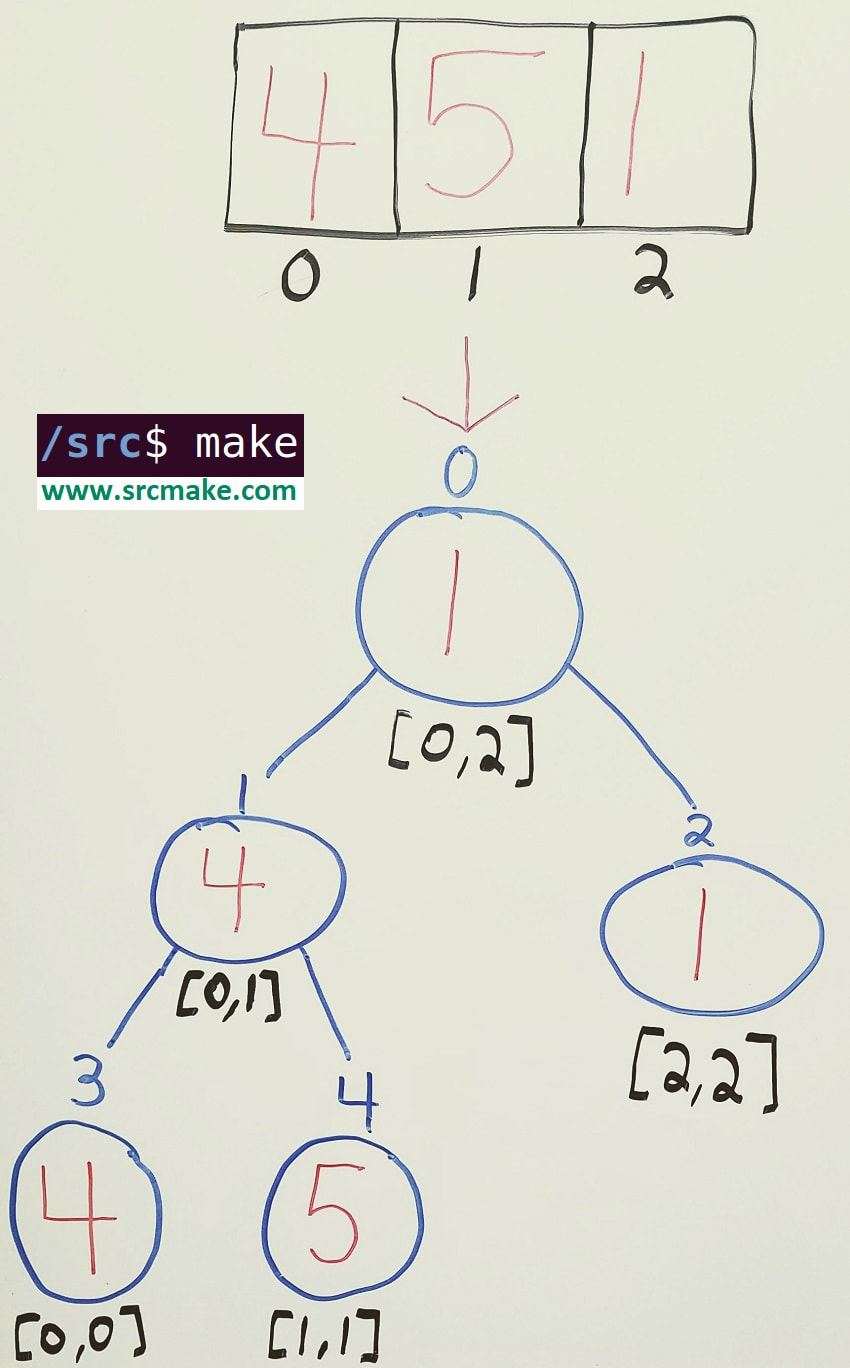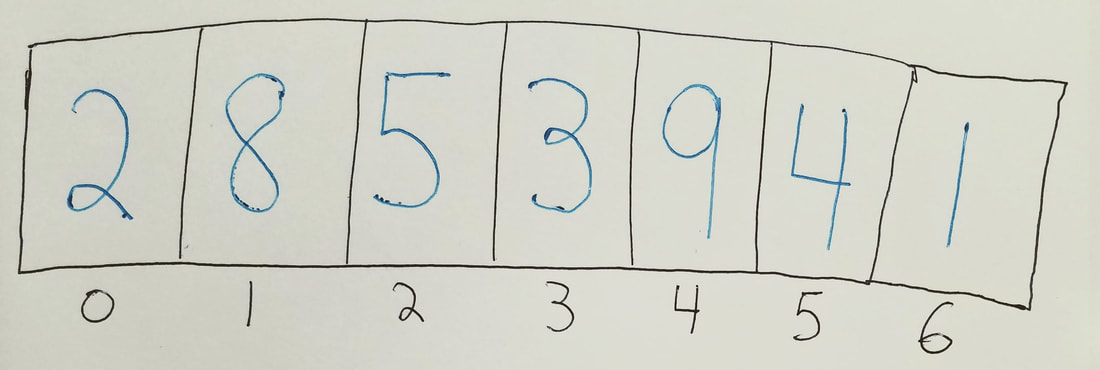|
To see the youtube video explaining this tutorial (which includes drawings that show how the recursion works), please click here.
The Problem - Repeatedly Finding The Minimum From A Range
Let's say that we have the following array.
What's the minimum value from index 0 to index 6? -> 1
What's the minimum value from index 0 to index 5? -> 2 What's the minimum value from index 1 to index 1? -> 8 What's the minimum value from index 4 to index 5? -> 4
It's easy to find the answer to these as a human looking at this small array, but how do we write a program to solve this?
Naive Algorithm - Use A For Loop
The simple thing to go through each number from index L to index R and check if the number at each index is smaller than the current minimum.
Here's some pseudocode that does that.
The running time of this function, used to query the array from range [L,R] is O(N), since we may be asked to query the entire array.
We don't have to do any extra work since we're given the array, so it costs O(1) extra space and O(1) time to build. And updating a value in the array costs O(1) time since we can access it's index directly. Note: It's possible to get the query time to be smaller by memoizing results after we calculate them, but it then requires O(N^2) space/time to build the table to store the values. These stats are pretty good, but it's possible to do even better using segment trees. Segment Trees
If you're asked to make multiple queries on subranges on an array, then segment trees are the ideal data structure to use.
The following sections will show how to build a segment tree structure, how to fill it with the appropriate values, how to query the segment tree for the value you need for a given subrange, and how to update the segment tree if a value of the original range changes. Building An Empty Segment Tree
The first thing we need to do is make an empty tree. The segment tree is represented as an array, we just need to know what the size of the array is.
Here's the pseudocode to calculate the array size and create the array.
This array represents our segment tree. (Each index of the array is a node in our tree.)
Filling In The Segment Tree With Values
Now that we've built our segment tree, we need to fill it in with the values.
To fill in the segment tree, starting at the root, we'll say that the minimum of a node is the lesser value of its two children, and so we recursively search children for their minimums. The nodes that represent just one element (ex. [4,4]), however will say it's minimum is just the single value it represents from the original array. Here's the pseudocode implementation for filling in the segment tree.
The running time of filling the values in the segment tree is O(N), since we visit each element of the original array once, and we touch each leaf of the segment tree once.
Querying The Segment Tree
After we've built a tree, we want to be able to search the tree for its values. (Which, in this case, is the minimum value between indices L and R.)
Similar to the technique we used before, we recursively search the tree, starting from the root, and if a node is within the range [L, R], then we check it's value as a valid minimum of the range.
The running time of this operation is O(log N). At worst, we'll have to go down the height of the tree twice, once for the left subtree, and one for the right subtree.
Updating A Value In The Segment Tree
If one of the elements of the original array needs to be updated with a new value, then we simply go through that element's direct path in the segment tree and update the minimum accordingly.
The running time is O(log N), since we only need to travel the height of the segment tree once. (The leaf node representing the updated index, up to the root of the tree.)
Adding/Deleting A Value In The Array
Basically, if you have to add a new value to the original array, then you have to construct a brand new segment tree. This ends up costing O(N) time to build the new tree. (Don't forget to delete the old tree.)
C++ Segment Tree Full Class Implementation
A full Segment Tree C++ implementation can be found on github here: https://github.com/srcmake/segment-tree
Note that the code was meant to be readable for this tutorial, and not necessarily "efficient". (Meaning some operations could be improved, or some code could be moved to functions. (Ex. Calculating the middle index.)) Here's a sample of the class definition (inside a file named segment-tree.hpp):
The code is similar to our pseudocode, with a few private variables included. (The definitions for each function can be found in the actual segment tree class file on github.
An example of using this class is...
Extending Segment Tree for Other Problems
This tutorial showed a Segment Tree designed for Range Minimum Queries (RMQ), specifically for storing integers, but of course segment trees can be extended for more than just finding the minimum.
We can also:
Conclusion
Segment trees are a data structure that comes up in algorithm competitions (and there's usually no time to code one from scratch), so it's better to have the code ready beforehand to copy and paste. So bookmark this blogpost, subscribe on youtube, and star the github repo.
Keep in mind that this tutorial was meant for demonstration purposes, and there are optimizations and edge cases we could've covered. Feel free to experiment with those on your own.
Like this content and want more? Feel free to look around and find another blog post that interests you. You can also contact me through one of the various social media channels.
Twitter: @srcmake Discord: srcmake#3644 Youtube: srcmake Twitch: www.twitch.tv/srcmake Github: srcmake Comments are closed.
|
AuthorHi, I'm srcmake. I play video games and develop software. Pro-tip: Click the "DIRECTORY" button in the menu to find a list of blog posts.

License: All code and instructions are provided under the MIT License.
|



